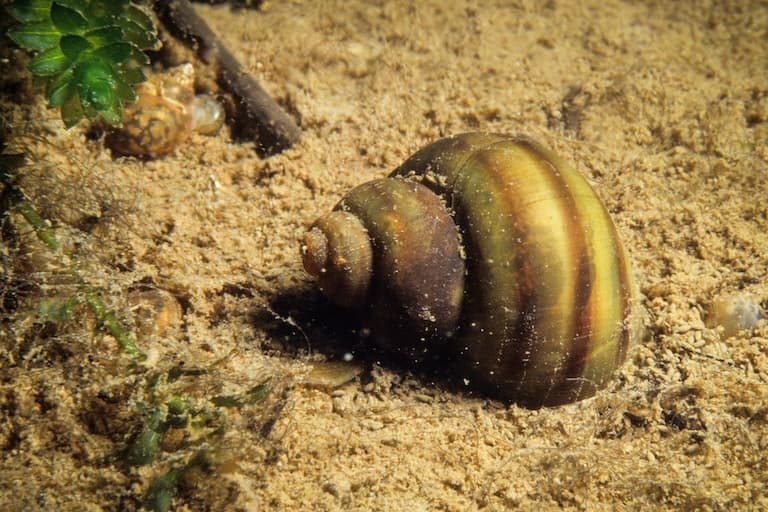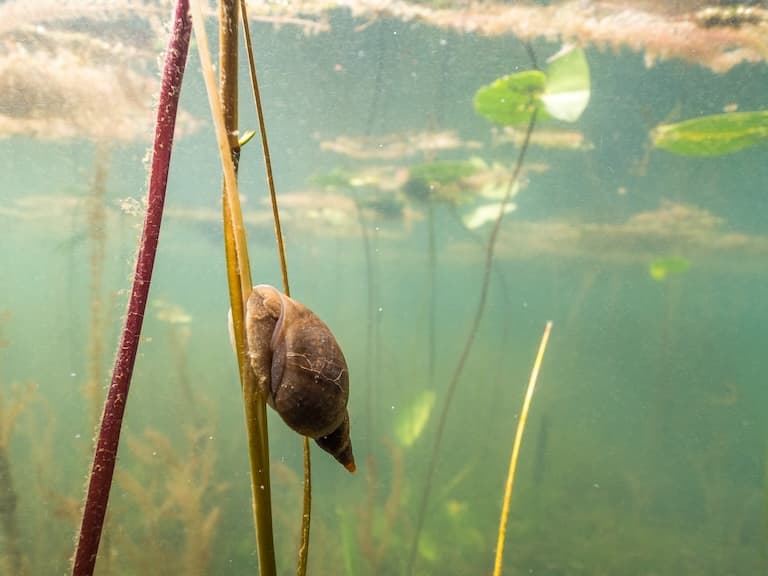Freshwater Snail Profile
If you’ve ever put your food in your mouth, you’ll know what gastropods have to live with on the daily. The name is Greek for “Stomach foot”, and refers to the strange position of snail anatomy. But it’s not only their anatomy that’s weird.
Snails are highly underrated as animals, having colonised almost everywhere after evolving in the ocean, moving onto land, and then going back into the water, this time, in rivers, streams and fish tanks – and doing it repeatedly.
Freshwater snails are therefore a diverse bunch of aquatic land marine invertebrates.

Freshwater Snail Facts Overview
| Habitat: | Freshwater, pretty much all of it |
| Location: | Worldwide |
| Lifespan: | 8+ years |
| Size: | More than 17cm (7 inches) in large species |
| Weight: | Over 200g in the largest species |
| Colour: | Varied, from dull to vibrant and patterned |
| Diet: | Everything |
| Predators: | Everything (mostly fish) |
| Top Speed: | Snail’s pace |
| No. of Species: | Around 5,200 known |
| Conservation Status: | Most are unlisted |
Freshwater snails are mediators of the majority of freshwater ecosystems worldwide.
They consume and are consumed, feeding on algae, flesh, and even other snails; and being fed upon by all of those and more in return.
As a group of thousands of species from several different lineages, they serve almost every role in their ecosystems, from filtering detritus out of the water to keeping the human population under control.
Interesting Freshwater Snail Facts
1. It all began in the ocean
Gastropods are molluscs and a branch that didn’t end up with either the two-shelled system of the bivalves or the weird alien cognition of the cephalopods.
Instead, they have one shell, and evolved probably as far back as the Cambrian, in the ocean. Limpets are examples of snails that never moved onto land, and land snails, like your common garden variety, are examples of those who did.
But, not content with dominion over land and sea lettuce, they ventured forth into lands – or liquids – thitherto unknown to snail kind.
These were the freshwater systems and were a great place to expand their leaf-munching philosophy, and a rare but gratifying opportunity to use the word thitherto. 1

2. Now there are loads of them
Freshwater snails now inhabit almost every freshwater habitat you can find. Leave the tap on pretty much anywhere in the world and eventually some of these guys will show up.
They live in rivers, lakes, streams, bogs, puddles, marshes, fens, tarns, loughs and billabongs, and occupy a tremendous range of niches from predators to filter feeders and various points in between.
Some have gills, some have lungs, and some have both, meaning that some can stay under forever, others have to come to the surface, and some can dip a foot in and decide whether to wait for the water to warm up.
This incredible diversity didn’t just occur from their ancestors radiating into various open niches, it happened, in part, because multiple lines of land snails have made the change over the years.
3. They’ve colonised freshwater many times
Nobody knows how many times snails got bored of being on land and evolved themselves into the water, but it appears to be more than 35.
This means that freshwater snails don’t all originate from a single adventurous land snail that boldly went where no snail had gone before, but that multiple ancient land snails were equally bold and ended up colonising their own local freshwater niches.
This is likely the key to their success, too, and with so many approaches, they serve a diverse range of purposes in their ecosystems.

4. They can clean water
Both filter feeders and active algae eaters serve as clean-up crew and can contribute to the quality of the water around them. Fish tanks benefit greatly from window licker species, and ponds can be kept relatively clear from species that thrive on the algae build-up there.
But there are also snails that don’t like people very much and do everything they can to make them very sick. 2
5. Or they can kill you
When you think of the deadliest animals on Earth, hippos, drop bears and Megalodons come to mind, but much in the same way mosquitos find themselves on the list, freshwater snails are indirectly responsible for hundreds of thousands of deaths a year.
But like the mosquito, the snail is actually just a vector and the real villain is the parasitic worm inside it. Schistosomiasis is a mouthful of a disease and is caused by parasitic flatworms of the genus Schistosoma.
These are no ordinary worms – they’re absolutely tiny and small enough to wriggle between the cells in your skin and burrow into your body, where they lay their eggs and start tinkering about with your wiring.
Part of the lifecycle of this horrible little parasite involves snails, who feed on the poop of infected animals, containing the eggs of the parasite.
Ultimately, they spread Schistosomiasis so prevalently that they are thought to be responsible for the second-most deaths after malaria. Africa and Asia are the hotbeds of Schistosomiasis, and the genus is thought to have originated in hippos.
The taxonomy of the worm isn’t finished yet, and it’s thought to be wrong, so it’s likely that the genus of the worm will end up being several genera at least, which might relieve the poor snails of their burden to some degree, but for now (at least, for the species that spread it) they’re terrible murders of children!
6. Assassin snails
A more direct approach to killing is found in the so-called assassin snails, whose name is a misnomer as they are decidedly apolitical animals.
Still, they are lethal, at least if you’re a small fish or some other fleshy creature of appropriate size. The insidiously-named Anentome Helena is a stiped, bee-coloured snail with a reputation.
It’s a member of the “dog whelk” family, also known as the assassin snails, known for burying themselves in the sediment and impaling worms, fish and other snails on a paralysing spike.
Interestingly, most of these snails are marine animals, but these somehow made the trip into freshwater, perhaps directly from the ocean.
These pretty animals are used to clear artificial ecosystems of pest snails and will also eat carrion. Another group from the same family are the Narcissus snails, valued for the same services, but like most aquarium snails, risk becoming invasive when people dump their tanks out into the local environment. 3
7. They can be invasive
A single female snail can produce tens of thousands of eggs in her lifespan, allowing for plenty of opportunities to explode in number when she finds herself in an ecosystem with little to stop her.
The giant apple snail is a good example and a popular species in the aquarium trade for their large size and useful cleaning services.
Mainly eating vegetation, they will also display omnivorous characteristics, and while they originate in South America, they’ve been released into the waterways of North America, and are proving to be quite destructive.
Luckily, there are many local things that eat them, such as raccoons and various birds, but this still counts to shift the balance of the ecosystem with yet-unknown consequences.

Freshwater Snail Fact-File Summary
Scientific Classification
| Kingdom: | Animalia |
| Phylum: | Mollusca |
| Class: | Gastropoda |
Fact Sources & References
- Thomas A Neubauer (2023), “The fossil record of freshwater Gastropoda – a global review”, Research Gate.
- Aquascaping Cube (2023), “Snail Escape? Top 5 reasons & solutions for snails coming out of water!”, YouTube.
- Beekam Kebede Olkeba (2020), “Environmental and biotic factors affecting freshwater snail intermediate hosts in the Ethiopian Rift Valley region”, Parasites and Vectors.
